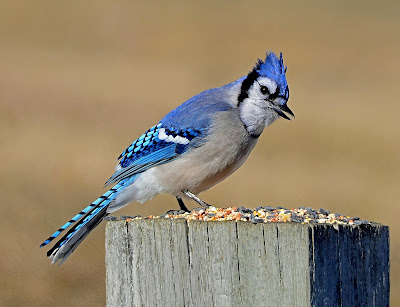Nature News: Blue jays are an oak's best friend
 |
Acorn-hoarding by blue jays is important to the spread of oak forests
throughout the northeast photo by Rodney Campbell
|
Blue jays are corvids, close cousins of the crows, ravens and magpies. Like crows, they are known for their intelligence and while they've never been observed using tools in the wild, according to the Cornell Lab of Ornithology, captive blue jays have used newspaper strips to rake food pellets into cages.
I've been watching jays come to my feeder and fly away with the acorns that I collected earlier this fall. I knew that jays love acorns and consume (and stash) an inordinate amount of acorns in the wild. But, I hadn't realized how important the jay was to the acorn. In the book "Animals' Influence on the Landscape and Ecological Importance: Natives, Newcomers, Homecomers," Friedrich-Karl Hotmeier discusses acorn hoarding by jays and the importance of this activity to the spread of oak trees. Jays (and squirrels) are major predators upon acorns, both carry acorns away from the trees and store (cache) a large percent of those acorns in the leaf litter. Jays can carry more than one acorn at a time thanks to an expandable throat that they can fill much like we fill a shopping bag, or a chipmunk its cheeks. One study found that blue jays had transported over 50 percent of the mast crop of acorns away from a stand of oak trees.
Both jays and squirrels have an awesome memory for where they've cached acorns, but still miss a lot and thereby inadvertently plant large numbers of oak trees. Acorns are heavy and don't fall far from the tree, so oaks rely upon predators to carry those acorns away from the tree to more favorable growing conditions. Think about all those acorns produced by the oak in your backyard - on good years the ground beneath the tree is littered with acorns. Most don't sprout. The acorns that do sprout usually don't do well since they are growing in the shade of the mother (seed) tree.
Jays might help the spread of oak trees even more than squirrels. According to Hotmeier, jays usually cache seeds further from the seed tree than squirrels. They preferentially select acorns that are most likely to germinate - they can tell a good nut from a bad one! Jays also tend to cache acorns in more open areas than squirrels, areas that are more favorable for germination than directly below the seed tree, because there is more light available to the young oak trees and there is less chance that they'll be affected by leaf-eating caterpillars that fall from the tree canopies. Another benefit of jay dispersal compared to squirrels is that squirrels tend to cache large amounts of acorns close together in piles called middens, in conditions that tend to inhibit germination while jays cache seeds singly. This helps protect the acorns from fungi that can plague crowded caches.
Jays have even been credited with speeding up the northward spread of oak trees after the last glaciation. It makes you wonder where our oak forests would be today without the blue jay. It makes me appreciate blue jays all the more as I watch them take acorns and bully the other birds at my birdfeeder.
Susan Pike, a researcher and an environmental sciences and biology teacher at St. Thomas Aquinas High School, welcomes your ideas for future column topics. She may be reached at spike3116@gmail.com. Read more of her Nature News columns online.


Comments
Post a Comment